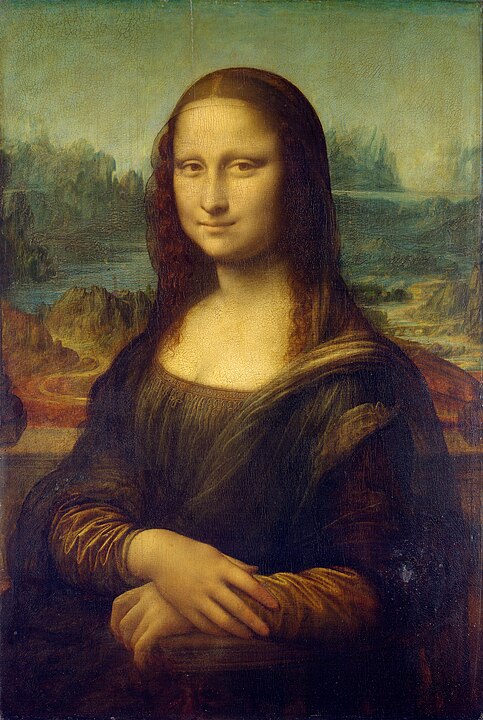Art, as we all know, has been a means of communication since the dawn of time. Paintings, the most common form of art, always convey messages, both negative and positive.
Famous painters have used their canvases to hide deep messages in their masterpieces. These mind-blowing paintings have intrigued people for generations, having portrayed themselves as results of deep work, creativity, intelligence and meaning.
In this article, we’ll be discussing 10 of these famous paintings with hidden meanings.
Table of Contents
10 Famous Paintings With Hidden Meanings
-
“Mona Lisa” – Leonardo da Vinci (1503-1506)
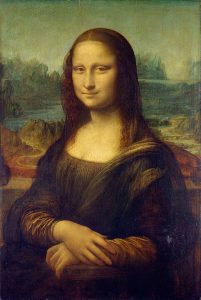
Mona Lisa
This is the most famous painting in the world, created by Leonardo da Vinci in the late 15th century. The Mona Lisa painting has left a lot of Art enthusiasts wondering how Leonardo came up with such a concept, and I’ll tell you why.
The painting is about a lady named Lisa Gherardini with her mysterious smile, which has intrigued many people. But here’s the most interesting part; Leonardo da Vinci was not just an artist but also a mathematician and a scientist.
He used a special mathematical concept called the golden ratio in the painting. This golden ratio is like a set of numerical values that appears in nature and is believed to represent beauty and balance. When you look closely at the painting, you’ll notice that the golden ratio is hidden in how Mona Lisa’s eyes follow you no matter where you’re positioned.
The painting also represents the Renaissance when people were curious about the world and learning all sorts of things. So “Mona Lisa” is not just about a lady; it symbolizes human creativity, curiosity, and how art and science can unite to make something incredible. Although this painting is centuries old, students at the college still study the history of its creation and write papers about it. And although hundreds of essays have already been written, they all serve as evidence that history continues to be valued and appreciated by us.
Ultimately, “Mona Lisa” is a timeless masterpiece about mysteries, creativity, and the beauty hidden in the world around us. So next time you see the painting, you’ll know there’s more to it than just a lady with a smile – it’s a true masterpiece with a special connection to math, science, and the Renaissance spirit! How cool is that!
-
“The Last Supper” – Leonardo da Vinci (1495-1498)
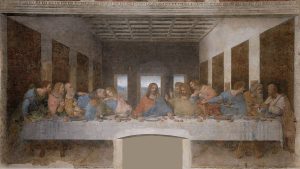
The Last Supper
Another famous painting by Leonardo da Vinci, “The Last Supper,” shows the sad moment of Jesus Christ revealing that one of his disciples would betray him. It’s not just a regular dinner scene; it’s a powerful moment in history.
Picture this: Jesus and his disciples are having a meal, and Jesus drops a bombshell – he tells them that one of his friends will betray him. Can you imagine the shock and emotions in that room?
Now, here’s where da Vinci’s genius comes in. He didn’t just paint a simple scene; he used the linear perspective to bring the painting back to life. The “linear perspective” is a surreal way of painting that makes everything look so realistic. So, when you look at the artwork, your eyes are automatically drawn to Jesus in the centre, making him the focal point of the whole scene. It’s like da Vinci wanted us to feel the weight of Jesus’ words and their significance.
Da Vinci also used symbols to show the disciples’ feelings about what Jesus said. Check out their hands – they’re making different gestures telling us how they react to the shocking news. It’s like a hidden language that adds more meaning to the painting.
In a nutshell, “The Last Supper” is more than just a painting. It’s a powerful story captured on canvas. Leonardo da Vinci was like a storytelling wizard, using tricks like perspective and symbols to make the painting speak to our hearts.
-
“The Persistence of Memory” – Salvador Dalí (1931)

The Persistence of Memory
“The Persistence of Memory” by Salvador Dalí is another famous painting with thoughtful and hidden meanings. In this artwork, you’ll see clocks that look like they’re blending and laying over all sorts of things. But here’s where it gets really interesting – there’s a hidden meaning behind it all!
This painting is about time and how it can feel weird and wobbly. You know how sometimes time flies when you’re having fun, but it drags on when you’re bored? Well, Dalí was fascinated by that idea. He wanted to show how time can feel all fluid and not fixed, just like those melting clocks.
And get this – the painting is also about how reality isn’t always as linear as it seems. The objects in the painting look all dreamy and warped, which makes you wonder what’s real and what’s not.
Dalí was really into the idea of the subconscious mind – the thoughts and feelings we might not even be aware of. He thought that seeing strange and surreal stuff messes with our sense of time and reality. That’s why you see those strange and melting clocks in the painting.
-
“Guernica” – Pablo Picasso (1937)
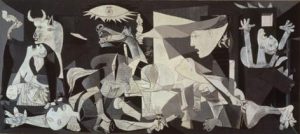
Guernica
Pablo Picasso’s “Guernica” is a powerful anti-war statement depicting the horrors of the 1937 bombing of Guernica during the Spanish Civil War. The famous painting’s hidden meaning lies in its symbolic representation of suffering and anguish caused by conflict. The figures and animals in the painting look so gloomy, representing all the terrible things that happen during conflicts.
Picasso wanted to show the world how innocent people and animals get caught up in the devastation of war. It’s like a cry for peace, a way to make people think about the real cost of violence and destruction.
When you look at “Guernica,” you can feel the emotions behind it – the sadness, the fear, and the anger. It’s a reminder that war brings so much pain and hurt to so many innocent lives.
This painting is not just about history; it’s a timeless message about the importance of finding peaceful solutions and the need to stop wars from ever happening again. It’s a really powerful work of art that makes you think and feel deeply about the impact of war on people and animals.
-
“Las Meninas” – Diego Velázquez (1656)

Las Meninas
Diego Velázquez’s “Las Meninas” is a captivating portrait of the Spanish princess Margaret Theresa and her entourage. The hidden meaning lies in Velázquez’s inclusion of himself in the painting, blurring the lines between the artist, the subject, and the viewer. It’s an intriguing commentary on artistic creation and the relationship between the painter, the subject, and the audience.
The painting invites us to be part of its enchanting world, where reality and artistry merge in a timeless dance of exploration and wonder.
You see, Velázquez’s decision to place himself in the painting is no random act. It’s a deliberate move that holds a deeper meaning. By doing so, he’s challenging the conventional norms of artistic creation. He’s not just a distant observer; he becomes an active participant in the artistic process.
-
“The Scream” – Edvard Munch (1893)

The Scream
Edvard Munch’s iconic painting “The Scream”, originally named in Norwegian as Skrik, expresses existential crisis and mental derangement. The famous painting was said to be painted by a madman due to its angsty nature.
The hidden meaning behind the haunting figure’s tormented face lies in the artist’s challenges with anxiety and the fear of the modern world. The vivid colors and distorted features trigger fear and unease, making it a disdainful representation of human vulnerability.
-
“The Birth of Venus” – Sandro Botticelli (1484-1486)
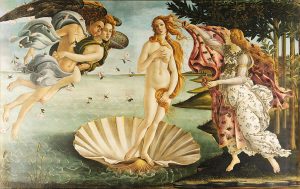
The Birth of Venus
“The Birth of Venus” by Sandro Botticelli is a famous painting from the Italian Renaissance. The hidden meaning of this painting lies in its representation of divine love and spiritual rebirth. The painting shows an image of the goddess Venus emerging from the sea’s shore after her birth. The image of Venus represents beauty and love, while the presence of the three Graces and Zephyr adds further layers of symbolism to the painting’s underlying message.
-
“The Garden of Earthly Delights” – Hieronymus Bosch (1490-1510)
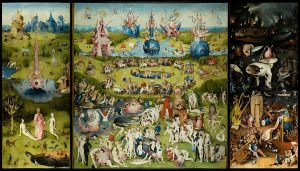
The Garden of Earthly Delights
Formerly known as Hieronymus Bosch’s Trip, “The Garden of Earthly Delights” is a bizarre and grotesque painting with hidden meanings within its intricate details. The left panel represents the creation of Adam and Eve, which represents birth, and the center panel depicts a world filled with sinful human activities. And the right panel reveals the deadly torment of Hell that awaits those who did not repent from their sins. The famous painting serves as a warning to those who indulge in earthly pleasures about the consequences of sinful behaviour.
-
“The Ambassadors” – Hans Holbein the Younger (1533)
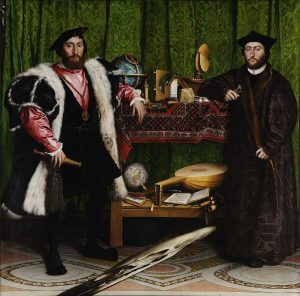
The Ambassadors
“The Ambassadors” by Hans Holbein the Younger is a famous painting created during the Tudor period. It was said to have been pioneered by the Queen at that time (Anne Boleyn) as a gift to Ambassador Jean de Dinteville.
However, the painting’s hidden meaning lies in the anamorphic skull in the foreground. When viewed from a specific angle, the skull becomes visible, serving as a memento mori, reminding viewers of their mortality and the transience of worldly achievements.
Also, many artists have debunked the theory that the painting depicts religious strife, which has been the major argument between the secular and the religious authorities of that time.
-
“The Starry Night” – Vincent van Gogh (1889)
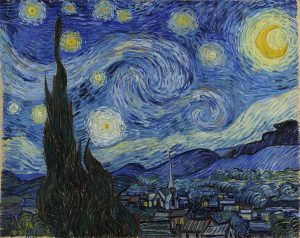
The Starry Night
Vincent van Gogh’s “The Starry Night” is an exceptional depiction of the night sky over Saint-Rémy-de-Provence. The hidden meaning in this famous painting lies in van Gogh’s emotional turmoil and mental struggles, which are believed to have influenced the spiral and dramatic representation of the sky.
He made this painting in 1889 inside his asylum room on an oil canvas. Vincent Van Gogh was a famous painter who suffered from severe depression. The view outside his window inspired Starry Night. However, the quaint houses depicted in the painting were not close to his view. The cypress tree seen in the foreground is also believed to symbolize death and eternity, adding a deeper layer of meaning to this iconic painting.
Conclusion
These famous paintings have more hidden meanings and messages that will probably take a gazillion years to decipher. We’ve been able to point out a few of these messages, but many Art enthusiasts argue there should be a lot more where that came from. These paintings have provided a window into our minds and perspectives on the human condition.
Exploring these hidden meanings has added allure and aesthetic value surrounding these celebrated works of art.
Read also these other insightful posts from us;
- Top 10 Historical Sites in Nigeria
- 6 Weird and Harmful Traditional Practices in Nigeria
- Ways to Boost Creativity in the Workplace
Oluwanifemi Akintomide edited this piece.
Was this helpful for you? Let us know your thoughts in the comment section, or speak to us on Whatsapp. Also, subscribe to our newsletter to receive notifications of our latest posts that will be of immense value to you.
About Author
Latest entries

 Business InsightsNovember 26, 2023How to Identify and Call Out Fake Bank Alert: Protect Your Business From Fraudulent Activity
Business InsightsNovember 26, 2023How to Identify and Call Out Fake Bank Alert: Protect Your Business From Fraudulent Activity FreelancingSeptember 6, 2023Setting up an Escrow Account for your Freelancing Business: A Step-by-step Guide
FreelancingSeptember 6, 2023Setting up an Escrow Account for your Freelancing Business: A Step-by-step Guide LifestyleAugust 4, 202310 Famous Paintings With Hidden Meanings That Will Wow You
LifestyleAugust 4, 202310 Famous Paintings With Hidden Meanings That Will Wow You

